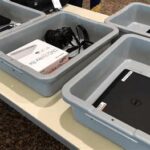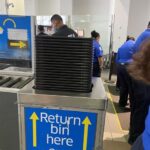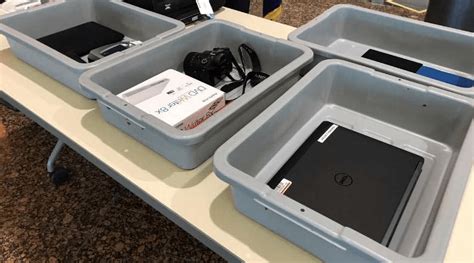
Wallets are the most frequently stolen items from Transportation Security Administration (TSA) security checkpoint bins, prompting security experts to warn travelers about the risks of placing them in these unsecured containers. Experts advise passengers to exercise caution and adopt strategies to safeguard their valuables while navigating airport security.
Travelers passing through airport security checkpoints should be particularly vigilant about their wallets, which are prime targets for theft as they transit through the screening process, according to industry experts. The hurried environment and the necessity to remove items like belts, shoes, and electronics contribute to an increased vulnerability for misplaced or stolen personal belongings.
“The number one item that is stolen at the security checkpoint is wallets,” said cybersecurity expert Adam Levin, co-founder of CyberScout, in an interview. This alarming statistic underscores the need for heightened awareness among travelers to protect their valuables from potential theft.
The TSA requires passengers to empty their pockets and place loose items, including wallets, phones, and keys, into bins for X-ray screening. This process temporarily separates travelers from their belongings, creating an opportunity for opportunistic thieves. While the TSA maintains that theft at security checkpoints is rare, anecdotal evidence and expert opinions suggest that it remains a persistent concern.
To mitigate the risk of theft, security experts recommend several proactive measures:
-
Keep Wallets Secure: Before entering the security line, place your wallet in a zippered compartment within your carry-on bag. This prevents easy access and keeps it secure throughout the screening process.
-
Maintain Visual Contact: Always keep an eye on your belongings as they move through the X-ray machine. This helps ensure that no one tampers with your items and allows you to quickly identify any discrepancies.
-
Retrieve Belongings Promptly: After passing through the metal detector, promptly gather your belongings from the bin and double-check to ensure everything is accounted for. Avoid lingering or getting distracted, which could make you vulnerable to theft.
-
Use TSA PreCheck: Consider enrolling in TSA PreCheck, which allows eligible travelers to keep their shoes, belts, and light jackets on during screening, reducing the need to remove items that could be misplaced or stolen.
-
Report Suspicious Activity: If you witness any suspicious behavior or believe your wallet has been stolen, immediately notify TSA personnel or airport security. Providing a detailed description of the incident can help authorities investigate and potentially recover your belongings.
The issue of theft at TSA checkpoints is not new, and numerous reports and anecdotes highlight the vulnerabilities in the screening process. While the TSA focuses primarily on security threats related to prohibited items, the risk of petty theft remains a significant concern for travelers.
One of the key challenges in addressing this issue is the difficulty in tracking and reporting thefts. Many incidents go unreported because travelers may not realize their wallet is missing until they reach their destination. Additionally, the hurried nature of airport security can make it difficult to identify the exact moment when a theft occurs.
To combat theft, the TSA employs various security measures, including surveillance cameras and personnel stationed at checkpoints. However, these measures are not always sufficient to deter determined thieves, particularly during peak travel times when checkpoints are crowded and chaotic.
In addition to the measures implemented by the TSA, travelers can take personal responsibility for safeguarding their belongings. By following the recommendations of security experts and remaining vigilant throughout the screening process, individuals can significantly reduce their risk of becoming victims of theft.
The prevalence of wallet theft at TSA checkpoints underscores the need for increased awareness and proactive measures. While the TSA continues to refine its security protocols, travelers must remain vigilant and take steps to protect their valuables. By keeping wallets secure, maintaining visual contact with belongings, and promptly reporting any suspicious activity, individuals can navigate airport security with greater confidence and peace of mind.
Deeper Analysis and Background Information
The issue of theft at airport security checkpoints is more nuanced than simply blaming the TSA or opportunistic thieves. It’s a complex interplay of human behavior, environmental factors, and security protocols that create an environment ripe for petty crime. Understanding these elements is crucial to developing effective preventative strategies.
The Psychology of the Security Checkpoint
Airport security checkpoints are inherently stressful environments. Passengers are often running late, anxious about their flights, and bombarded with instructions from TSA agents. This heightened state of anxiety can impair cognitive function, making individuals less attentive to their surroundings and more likely to make mistakes, such as leaving a wallet unattended.
Furthermore, the feeling of being under surveillance can paradoxically reduce a person’s sense of personal responsibility. Passengers may assume that because they are being watched, their belongings are automatically protected, leading to a false sense of security. This “bystander effect” can make people less likely to intervene if they witness suspicious activity.
The Environmental Factors
The physical layout of security checkpoints also contributes to the problem. The conveyor belts, bins, and crowded waiting areas create a chaotic and confusing environment. It’s easy for items to get misplaced or mixed up, especially during peak travel times when checkpoints are congested.
The design of the bins themselves can also be problematic. The open-top design offers little protection against theft, and the lack of individual compartments makes it easy for items to slide around and become obscured. The bins are also often stacked on top of each other, making it difficult to keep track of belongings.
TSA Protocols and Limitations
While the TSA’s primary mission is to prevent terrorism and other security threats, the agency also has a responsibility to protect passengers’ belongings. However, the TSA’s resources are primarily focused on detecting prohibited items, such as weapons and explosives. This means that theft prevention often takes a backseat to other security priorities.
The TSA employs various security measures to deter theft, including surveillance cameras, plainclothes officers, and employee background checks. However, these measures are not always effective, especially during peak travel times when checkpoints are overwhelmed. The TSA also faces limitations in its ability to investigate and prosecute theft cases, as it often lacks the resources and jurisdiction to pursue these matters effectively.
The Role of Technology
Technology could play a significant role in reducing theft at TSA checkpoints. For example, biometric identification systems could be used to track passengers’ belongings as they move through the screening process. RFID tags could be attached to items, allowing passengers to monitor their location in real-time via a mobile app.
Smart bins could also be developed to enhance security. These bins could be equipped with sensors that detect when an item is removed, triggering an alarm if the passenger doesn’t match the item’s owner. The bins could also be designed with individual compartments to prevent items from sliding around and becoming obscured.
Beyond the Checkpoint: Identity Theft Concerns
The theft of a wallet is not just a matter of losing cash or credit cards. It can also lead to identity theft, which can have far-reaching consequences. A stolen wallet often contains personal information, such as driver’s licenses, social security cards, and medical insurance cards. This information can be used to open fraudulent accounts, file false tax returns, and commit other forms of identity theft.
To mitigate the risk of identity theft, travelers should take steps to protect their personal information. This includes carrying only essential documents, shredding unnecessary papers, and monitoring credit reports for suspicious activity. It’s also important to report a stolen wallet to the police and credit card companies as soon as possible.
The Impact on Traveler Confidence
The prevalence of theft at TSA checkpoints can erode traveler confidence in the security system. If passengers don’t feel that their belongings are safe, they may be less likely to cooperate with security procedures, potentially compromising overall security effectiveness.
Restoring traveler confidence requires a multi-faceted approach that includes enhanced security measures, improved communication, and increased transparency. The TSA should actively communicate with travelers about the steps it is taking to prevent theft and provide clear instructions on how to protect their belongings. The agency should also be transparent about the number of theft incidents and the measures it is taking to address the problem.
Ethical Considerations
The issue of theft at TSA checkpoints raises several ethical considerations. The TSA has a moral obligation to protect passengers’ belongings, even if its primary mission is to prevent terrorism. Passengers have a right to expect that their belongings will be safe and secure while they are undergoing security screening.
The potential for profiling also raises ethical concerns. If TSA agents are targeting certain groups of passengers for heightened scrutiny, this could lead to discrimination and unfair treatment. It’s important for the TSA to ensure that its security procedures are applied fairly and equitably to all passengers.
Legal Implications
The theft of a wallet at a TSA checkpoint can have legal implications. If the theft is committed by a TSA employee, the employee could face criminal charges and disciplinary action. The TSA could also be held liable for negligence if it fails to provide adequate security measures to protect passengers’ belongings.
Passengers who have had their wallets stolen at TSA checkpoints may have legal recourse. They can file a claim with the TSA for reimbursement of their losses. They can also file a lawsuit against the TSA if they believe that the agency was negligent in its security procedures.
The Future of Security Checkpoints
The future of airport security checkpoints is likely to be shaped by technological advancements and evolving security threats. Advanced imaging technology, biometric identification systems, and artificial intelligence could all play a role in enhancing security and reducing the risk of theft.
However, technology alone is not a panacea. It’s important to strike a balance between security and privacy, and to ensure that security procedures are applied fairly and equitably to all passengers. The human element will always be a critical component of airport security, and TSA agents will need to be well-trained and vigilant in order to detect and prevent both security threats and theft.
Expanded Context: Historical Perspective on Airport Security
Airport security measures have undergone significant transformations since the early days of commercial aviation. Prior to the 1970s, airport security was relatively lax, with limited screening of passengers and baggage. The focus was primarily on preventing hijacking, which was a growing concern at the time.
The 1970s witnessed a significant increase in terrorist attacks and hijackings, prompting governments around the world to implement stricter security measures. The introduction of metal detectors and X-ray machines became commonplace, and passengers were required to undergo mandatory screening.
The creation of the TSA in the wake of the September 11, 2001 terrorist attacks marked a watershed moment in airport security. The TSA assumed responsibility for all aspects of airport security, including passenger and baggage screening, law enforcement, and security technology. The agency implemented a range of new security measures, including enhanced screening procedures, reinforced cockpit doors, and increased air marshal presence.
Despite these improvements, vulnerabilities remain in the airport security system, including the risk of theft at security checkpoints. Addressing these vulnerabilities requires a comprehensive approach that includes enhanced security measures, improved communication, and increased traveler awareness.
FAQ Section:
1. What is the most commonly stolen item at TSA security checkpoints?
According to security experts, wallets are the most frequently stolen items at TSA security checkpoints. This is due to the requirement that passengers remove them from their pockets and place them in unsecured bins during the screening process. As Adam Levin, co-founder of CyberScout, notes, “The number one item that is stolen at the security checkpoint is wallets.”
2. Why are wallets particularly vulnerable to theft at airport security?
Wallets are vulnerable because the security screening process requires passengers to temporarily separate from their belongings. This creates an opportunity for opportunistic thieves to take advantage of the situation. The hurried environment and the necessity to remove items like belts, shoes, and electronics further contribute to the risk.
3. What steps can travelers take to protect their wallets at airport security?
Travelers can take several proactive measures to protect their wallets:
- Place your wallet in a zippered compartment within your carry-on bag before entering the security line.
- Maintain visual contact with your belongings as they move through the X-ray machine.
- Retrieve your belongings promptly after passing through the metal detector and double-check to ensure everything is accounted for.
- Consider enrolling in TSA PreCheck to reduce the need to remove items that could be misplaced or stolen.
- Report any suspicious activity to TSA personnel or airport security immediately.
4. What does the TSA do to prevent theft at security checkpoints?
The TSA employs various security measures, including surveillance cameras and personnel stationed at checkpoints, to deter theft. However, these measures are not always sufficient to prevent determined thieves, particularly during peak travel times when checkpoints are crowded.
5. What should I do if my wallet is stolen at a TSA security checkpoint?
If you believe your wallet has been stolen, immediately notify TSA personnel or airport security. Provide a detailed description of the incident to help authorities investigate and potentially recover your belongings. You should also report the theft to the police and your credit card companies as soon as possible to prevent further fraud. Additionally, monitor your credit reports for any suspicious activity.









